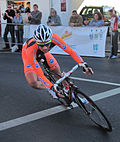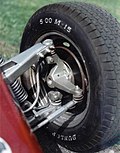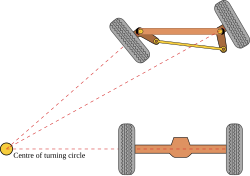Steering
Steering is the collection of mechanical parts which allow a vessel (ship, boat) or vehicle (truck, car, motorcycle or bicycle) to follow the desired course. Rail transport vehicles (trains and trams or streetcars) are steered by their rail tracks.
In vehicle steering, the person turning the steering wheel directly controls the rate of the turn. Response is immediate. Submarines and ships operate in water, and use control surfaces that work on the fluid. There is a delay between the steering controls and the time it takes for the system to respond.[1]
Some land vehicles such as tanks, and some boats, can use differential steering, in which one side is pushed forward.
Steering Media
Part of a car steering mechanism: tie rod, steering arm, king pin axis (using ball joints)
Rack and pinion unit mounted in the cockpit of an Ariel Atom sports car chassis, atypical of contemporary production automobiles
Articulated steering on a bandvagn 206.
References
- ↑ Robert W. Proctor; Trisha Van Zandt, Human Factors in Simple and Complex Systems, Second Edition (Boca Raton: CRC Press, 2008), p. 406








